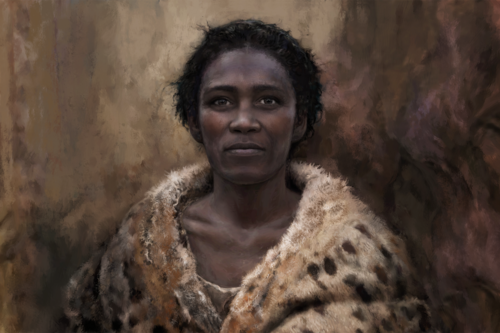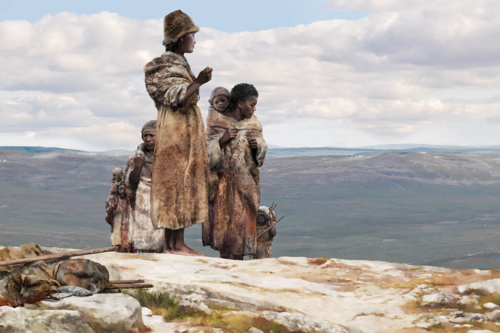
Illustration of Zlatý kůň, who belonged to the same population as the Ranis individuals and was closely related to two of them. © Tom Björklund for MPI for Evolutionary Anthropology

Illustration of the Zlatý kůň/Ranis group by Tom Björklund. Around 45,000 years ago, individuals from Ranis in Germany and Zlatý kůň in Czechia likely traveled together across the open steppe landscapes of Europe© Tom Björklund for MPI for Evolutionary Anthropology
The oldest DNA ever recovered from modern humans shows they arrived as small groups in Europe more than 45,000 years ago and mixed with Neanderthals - but left no descendants.
Published today (Thursday 12 December) in Nature, the study was led by scientists from the Max Planck Institute for Evolutionary Anthropology in Leipzig (Germany) and involved contributions from researchers at the University of Reading and University of Bristol.
DNA from bone remains found in Ranis, Germany, revealed some of the individuals were close relatives - including a mother and daughter - while others were more distant cousins. The DNA from a woman's skull found at Zlatý kůň, Czechia, turned out to be part of the same extended family.
Despite being among the first modern humans in Europe, this family group did not leave any descendants who are alive today. They were part of a pioneer population that eventually died out, making them a 'lost branch' of the human family tree.
Zooarchaeologist Dr Geoff Smith studied more than a thousand bone fragments found at the site of Ranis and Dr Karen Ruebens helped identify them through ancient protein analyses. Dr Ruebens and Dr Smith are now leading a new project at Reading analysing more bone fragments from the region to gain further insights into the diet and lives of these early modern humans and their Neanderthal counterparts.
Dr Karen Ruebens: "It is astounding how these small bone fragments provide such a wealth of data. Ranis turned out to be a real treasure trove. Exceptional DNA preservation gave a unique glimpse into past family groups and their wider connections across Ice Age Europe. It shows an ebb and flow of small human groups during a crucial period of coexistence between Homo sapiens and Neanderthals."
These early Europeans numbered just a few hundred and had dark skin, dark hair, and brown eyes, reflecting their arrival from Africa. One of the most significant findings was that these modern humans and Neanderthals mixed and had children together between 45,000 and 49,000 years ago, but there was no evidence for more recent interbreeding as is the case in other European modern human groups.
Dr Geoff Smith said: "These DNA results are exciting because they show differences in how frequently various groups of early modern humans met with Neanderthals. It is fascinating how these early modern humans were able to adapt to extreme cold conditions but were ultimately unsuccessful and died out."
Dr Helen Fewlass, an archaeological scientist at the University of Bristol's Department of Anthropology and Archaeology, started working on the Ranis project while based at the Max Planck Institute in Leipzig and has led the radiocarbon dating at the site, including directly dating the human remains analysed in the study. She said: "The preservation of the ancient bone fragments from Ranis is unprecedented and has given us a huge amount of information about these ancient people. These are the earliest directly dated remains of our species we have yet found in Europe and it's so exciting to find multiple individuals from one group. The new DNA results give us incredible insights into the lives of this pioneering group."
Paper:
'Earliest modern human genomes constrain timing of Neanderthal admixture' by A. Sümer et al in Nature






